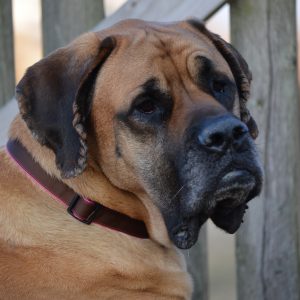Temperament
Dominance levels vary, even within the same litter, but they are often called a gentle giant. A born guard dog, they rarely bark, but it is in its nature to defend their territory and family, and is more a silent guard rather than a barker. When an intruder is caught they are more likely to hold them at bay, either by trapping them in a corner or laying on top of them rather than an all out attack. You do not need to train them to guard. No matter how friendly they are, if they sense danger they will naturally guard on their own unless the owners are there to tell them otherwise. Self-confident and watchful, they are patient and considered excellent with children. Intelligent, calm, even-tempered and docile. This breed is very large and heavy. They respond well to firm, but gentle, patient training. They love to please and need a lot of human leadership. Socialize them well to prevent them from becoming aloof with strangers. Owners need to be firm, calm, consistent, confident with an air of natural authority to communicate to the Mastiff that dominance is unwanted. If socialized with proper leadership it will get along well with other dogs. The Mastiff tends to drool, wheeze and snore loudly. They can be somewhat difficult to train. The objective in training this dog is to achieve a pack leader status. It is a natural instinct for a dog to have an order in their pack. When we humans live with dog, we become their pack.
Height, Weight
Height: Males from 30 inches (76cm) Females from 27 inches (69cm)
Weight: Males about 160 to 200 pounds (72kg) Females about 150 to 180 pounds (68kg)
One of the heaviest breeds; a male Mastiff can exceed 200 pounds.
Health Problems
Beware of canine hip dysplasia (“CHD”). As these dogs are prone to bloat, feed two or three small meals a day, instead of one large one. Also prone to CHD, gastric torsion, ectropion, persistent pupillary membrane, vaginal hyperplasia, elbow dysplasia and progressive retinal atrophy. Occasionally seen is cardiomyopathy.
Living Conditions
The Mastiff will do okay in an apartment if it is sufficiently exercised. They are relatively inactive indoors and a small yard will do.
Exercise
Mastiffs are inclined to be lazy but they will keep fitter and happier if given regular exercise. Like all dogs, the Mastiff should be taken on regular daily walks to help release it’s mental and physical energy. It’s in a dogs nature to walk. While out on the walk the dog must be made to heel beside or behind the person holding the lead, as in a dog’s mind the leader leads the way, and that leader needs to be the human. They should always be leashed in public.
Life Expectancy
About 10-12 years.
Grooming
The smooth, short-haired coat is easy to groom. Brush with a firm bristle brush and wipe over with a piece of toweling or chamois for a gleaming finish. Bathe or dry shampoo when necessary. This breed is an average shedder.
Origin
The Mastiff was founded in Britain. A very old breed, it was depicted in Egyptian monuments as early as 3000 BC. The breed fought alongside the British soldiers in 55 BC. Caesar brought a pack of Mastiffs to Rome where the dogs were put on display as an arena gladiator and forced to be in fights with human gladiators, lions, bull baiting, bear baiting and in dog to dog combat. They later became popular with the peasants in England where it was used as a bodyguard, protector of wolves and other dangerous predators and as a companion dog. It is believed that a Mastiff came to America on the Mayflower. Later more were imported. Like most breeds by the end of World War ll the breed was almost extinct in England. Dogs were imported from the USA and Canada and are once again well established in England. Some of the Mastiff’s talents include: watchdog, guarding, police work, military work, search & rescue, and weight pulling.
Courtesy of http://www.dogbreedinfo.com/mastiff.htm
More Mastiff Information
http://mastiff.org/MASTIFFFAQ.htm
http://www.akc.org/breeds/mastiff/
http://animal.discovery.com/breed-selector/dog-breeds/working/mastiff.html
http://en.wikipedia.org/wiki/English_Mastiff
http://www.vetstreet.com/dogs/mastiff

